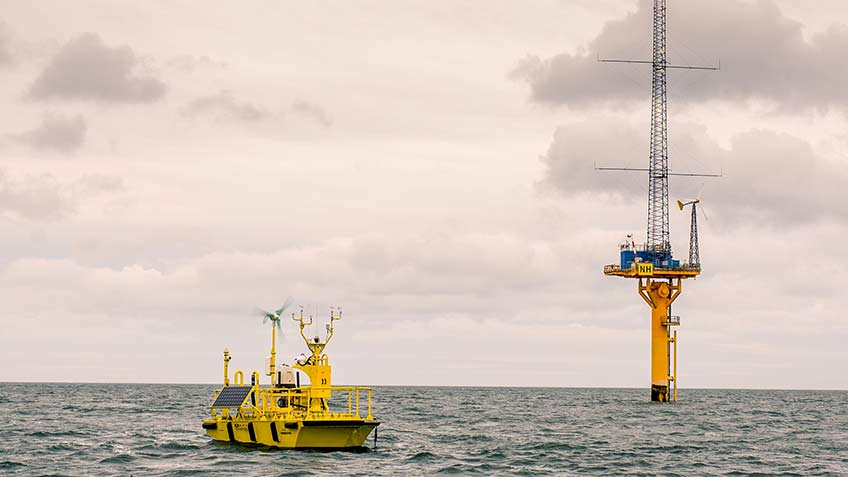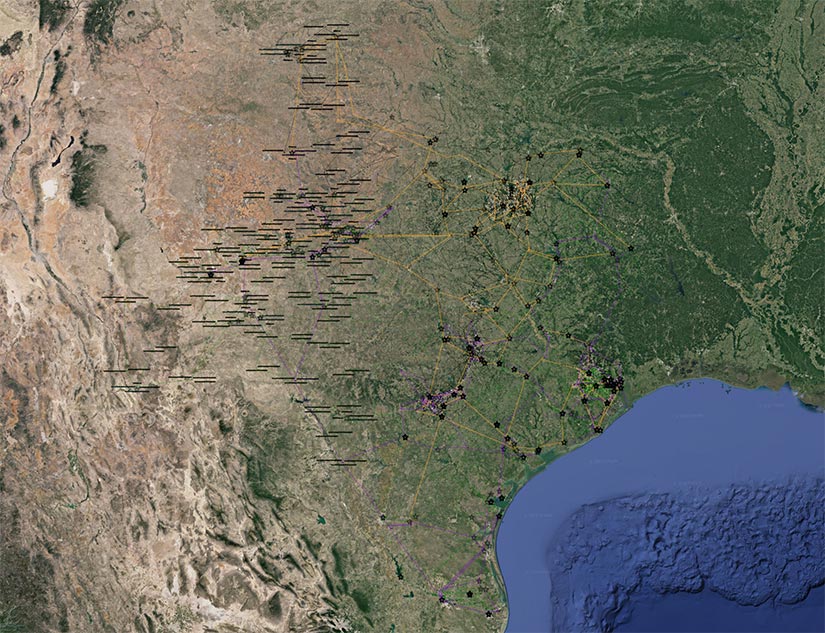The Leading Edge: April 2021 Wind Energy Newsletter
In this edition, NREL unveils new offshore data sets, the engineering modeling tool FAST.Farm makes its debut, and we investigate how NREL's impedance measurement system can provide dynamic stability to renewable energies.
News Stories
Offshore Wind Data Release Propels Wind Prospecting
NREL has released several new offshore wind data sets that represent 20-year time spans. Using state-of-the-art modeling tools and sophisticated resource assessment technologies, these updated data sets provide wind energy developers, consultants, and researchers access to high-quality wind resource information that can inform future offshore wind energy siting decisions and research.

New NREL Tool Can Help Maximize Wind Farm Power Production and Reliability
A single wind turbine's ability to convert wind into electricity is a marvel of engineering. But in a wind farm, where one turbine may be surrounded by many others, all downstream turbines are impacted by turbulence, changes in wind speed and direction, and the wakes created by the upstream turbines. This places additional load on each wind turbine in the farm and can impact the power production and reliability of the entire project.
FAST.Farm, a new midfidelity, physics-based engineering modeling tool from NREL, can be used to predict the power performance and structural loads of wind turbines within a wind farm. An extension of OpenFAST, NREL's open-source wind turbine engineering tool, FAST.Farm addresses the dynamics of, and interaction among, each individual turbine in a wind farm. FAST.Farm also considers the physics of farmwide ambient wind in the layer of the atmosphere in which wind turbines operate, changes in wake shape with downstream distance, wake movements caused by background turbulence, and farmwide control.
NREL Clears Hurdle to Dynamic Stability for Renewables
To strengthen bulk grid stability for highly renewable grids, NREL has developed a first-of-its-kind impedance measurement system that offers breakthrough capabilities for understanding how wind, solar, and other modern energy devices interact to affect the grid's moment-to-moment stability.

On the Radar
Addressing Environmental Concerns Associated with Wind Energy Development
Please join us Wednesday, May 12, from 9 to 10:15 a.m. Mountain Time for the next webinar in the Wind Energy Science Leadership Series. In this webinar at the intersection of species conservation and wind energy development, a panel of NREL researchers will discuss research, engagement, and technological development activities to address environmental concerns associated with wind energy.
Visit the Wind Energy Science Leadership Series to learn more about the event and to register.
NREL Researchers Receive 2021 Excellence Awards

Three NREL researchers—Bob Thresher, Bethany Frew, and Shawn Sheng—have received 2021 Excellence Awards from the Energy Systems Integration Group, a nonprofit educational organization dedicated to critical analysis of wind energy for utility applications.
Sheng received an excellence award for expanding the characterization and understanding of phenomena in wind turbine component operations and technical issues. Frew received an excellence award for contributions to market design for a renewable energy future. Emeritus researcher Thresher received a lifetime achievement award for his contributions to advancing wind energy technology internationally through his work at NREL.
Downwind: In Case You Missed It
Misfortune Moves Concepts from Theory to Real-World Application
Scientific American reported on a case of NREL turning lemons into lemonade when the explosion of a new transformer at NREL's Flatirons Campus provided an opportunity to restart a large power system using only renewable power. Energy experts at NREL have been studying this question for years, but this was the first time renewables have been used to restart a large power system without bringing in outside power using a practice called "islanding."
Publications
An Overview of Wind-Energy-Production Prediction Bias, Losses, and Uncertainties
Wind farm financing decisions directly relate to preconstruction energy yield assessments that estimate the annual energy production for the farm. The accuracy and precision of energy estimates can dictate the profitability of the wind energy project. Researchers published an article in Wind Energy Science that identifies a long-term trend of reduction in overprediction bias and summarizes recent advancements of wind resource assessment processes that help reduce prediction bias, including improvements in modeling and measurement techniques. Article findings highlight further opportunities for the industry to boost energy production, including efforts to reduce energy losses resulting from wind turbine wake effects and environmental events.
Spatial Impacts of Technological Innovations on the Levelized Cost of Energy for Offshore Wind Power Plants in the United States
This study evaluates the spatial variability of levelized cost of energy (LCOE) caused by technology-induced decreases in a range of capital, operational, and financial cost categories. Using a spatial cost model of fixed-bottom and floating offshore wind power plants to model the impact across thousands of potential U.S. sites, the authors found that a specified change in an individual turbine subsystem cost produces a range of LCOE outcomes resulting from the varying geospatial characteristics of the considered sites and the nonlinear, interactive dependency on these input parameters. This work expands on the existing offshore wind literature, which typically evaluates cost sensitivities at a single site and does not consider the spatial variance in LCOE. The results suggest that the impact of technological innovations can be significant and should be considered on a spatial as well as temporal basis when prioritizing technology innovation research or funding decisions to advance offshore wind technologies in the United States.
Proceedings from the State of the Science and Technology for Minimizing Impacts to Bats from Wind Energy
As wind energy deployment continues to increase, wind project developers look for ways to minimize the impact of wind projects on bats and other local wildlife. This report shares the objectives, discussion, and recommendations from a workshop, State of the Science and Technology for Minimizing Impacts to Bats from Wind Energy, hosted by the U.S. Department of Energy and NREL in November 2019. The workshop findings characterized the status of current technologies, identified emerging technologies, and discussed the research and development opportunities to facilitate implementation of effective strategies for minimizing bat interaction with wind turbines. In addition, the workshop focused on the biological, economic, and regulatory aspects associated with validating and integrating deterrents or smart curtailment systems at wind energy facilities.
Wake Steering of Multirotor Wind Turbines
This Wind Energy article describes research that applied wake steering to multirotor turbines to determine whether this form of steering has the potential to reduce wind power plant wake losses. By applying rotor yaw to multirotor turbines, the researchers introduced a new degree of freedom to wind farm control that allows wakes to be expanded, channeled, or redirected to improve inflow conditions for downstream turbines. Looking at five yaw configurations, including a baseline case, the researchers employed large‐eddy simulations to generate a detailed representation of the velocity field downwind of a multirotor wind turbine. In addition, they extended two lower‐fidelity models from single‐rotor yaw studies to the multirotor case and compared with the LES data. These findings show that rotor yaw can have a considerable impact on both the distribution and magnitude of the wake velocity deficit, leading to power gains for downstream wind turbines.
Share

